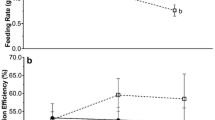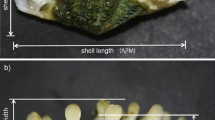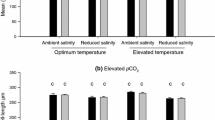Abstract
On the eastern shore of Nova Scotia late summer atmospheric systems cause upwelling of shelf water; the associated temperature variations of 10 °C with a 6 to 8 d period are comparable in magnitude to the seasonal variation. A laboratory study was undertaken to assess the effects of these temperature fluctuations on sea scallop (Placopecten magellanicus) growth and metabolism. In a factorial design, scallops were subjected to constant (10 °C) or a variable (6 to 15 °C) 8 d temperature cycle, and either a low (seston in filtered seawater) or high (seston supplemented with cultured phytoplankton) food diet. During the 48 d experiment scallop mortality was low and growth positive in all treatments. Shell and total tissue growth rate did not differ between temperature treatments, but growth in the high food treatments was 40 to 50% higher than in the low food treatments. However, soft tissue (excluding adductor) growth did show a temperature treatment effect; growth rates were significantly higher in the fluctuating temperature treatment, due in part to greater gonad development. Weight-standardized rates of scallop oxygen consumption (V sO2 , μmol O2 g−1 h−1) were 20 to 25% higher in high food than in low food treatments, consistent with the expected increase in respiration due to the higher growth rates. Scallop metabolism did not acclimate to the fluctuating temperature cycle; V sO2 and ammonium excretion (V sNH+ 4, μmol O2 g−1 h−1) remained dependent on ambient temperature throughout the experiment. V sNH+ 4 Q10 (2.77) was higher than V sO2 Q10 (2.01) which was reflected in a decrease in the O:N ratio at 15 °C, indicating a shift toward increased protein catabolism and a stressed state. At 10 °C, V sO2 and V sNH+ 4 in the variable temperature treatments were 15 to 18% lower than in the constant temperature treatments, a difference that was not detected in growth measurements. Results demonstrate that the metabolism of Placopecten magellanicus, unlike some bivalve species, is tightly coupled to fluctuations in ambient temperature. Although an absence of compensatory acclimation had a minimal effect on growth in this study, if high temperatures were combined with low food conditions a reduction in scallop production could result.
Similar content being viewed by others
Author information
Authors and Affiliations
Additional information
Received: 23 June 1998 / Accepted: 8 February 1999
Rights and permissions
About this article
Cite this article
Pilditch, C., Grant, J. Effect of temperature fluctuations and food supply on the growth and metabolism of juvenile sea scallops (Placopecten magellanicus). Marine Biology 134, 235–248 (1999). https://doi.org/10.1007/s002270050542
Issue Date:
DOI: https://doi.org/10.1007/s002270050542




